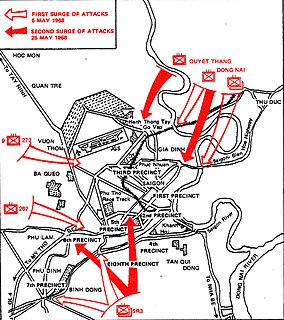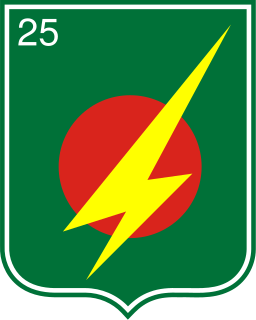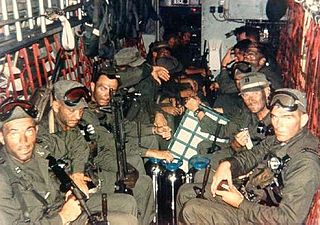
The Battle of Đồng Xoài was a major battle fought during the Vietnam War as part of the Viet Cong (VC) Summer Offensive of 1965. It took place in Phước Long Province, South Vietnam, between June 9 and 13, 1965.

The Cambodian campaign was a brief series of military operations conducted in eastern Cambodia in 1970 by South Vietnam and the United States as an extension of the Vietnam War and the Cambodian Civil War. Thirteen major operations were conducted by the Army of the Republic of Vietnam (ARVN) between 29 April and 22 July and by U.S. forces between 1 May and 30 June 1970.
The Battle of An Lão was a battle that took place in the An Lão District of Bình Định Province, just over 300 miles north-east of Saigon between December 7–9, 1964. The battle was part of a larger 5th Military Region operation known as Campaign An Lão to capture An Lão valley, and use it as a corridor between their military bases in Quảng Ngãi Province and Bình Định Province.

The Battle of Lộc Ninh was a major battle fought during the Easter Offensive during the Vietnam War, which took place in Bình Long Province, South Vietnam between 4 and 7 April 1972. Towards the end of 1971, North Vietnamese leaders decided to launch a major offensive against South Vietnam, with the objective of destroying Army of the Republic of Vietnam (ARVN) units and capturing as much territory as possible, in order to strengthen their bargaining position in the Paris Peace Accords. On 30 March 1972, two People's Army of Vietnam (PAVN) divisions smashed through the Vietnamese Demilitarized Zone, marking the commencement of the Easter Offensive. They quickly overwhelmed South Vietnamese units in the I Corps Tactical Zone. With the rapid collapse of South Vietnamese forces in the northern provinces of South Vietnam, PAVN and Viet Cong (VC) forces began preparing for their next offensive, targeting Bình Long Province in the rubber plantation region north of Saigon. On 4 April, the VC 5th Division opened their attack on Lộc Ninh, defended by the ARVN 9th Infantry Regiment. After three days of fighting, the vastly outnumbered ARVN forces, though well supported by American air power, were forced to abandon their positions in Lộc Ninh.

Operation Game Warden was a joint operation conducted by the United States Navy and South Vietnamese Navy in order to deny Viet Cong access to resources in the Mekong Delta. Game Warden and its counterpart Operation Market Time are considered to be two of the most successful U.S. Naval actions during the Vietnam War.

The Vietnamese Rangers, commonly known as the ARVN Rangers, were the light infantry of the Army of the Republic of Vietnam. Trained and assisted by American Special Forces and Ranger advisers, the Vietnamese Rangers infiltrated beyond enemy lines in search and destroy missions. Initially trained as a counter-insurgency light infantry force by removing the fourth company each of the existing infantry battalions, they later expanded into a swing force capable of conventional as well as counter-insurgency operations, and were relied on to retake captured regions. Later during Vietnamization the Civilian Irregular Defense Group program was transferred from MACV and integrated as Border Battalions responsible for manning remote outposts in the Central Highlands.

War Zone D was the area in South Vietnam around the Dong Nai River, north of Bien Hoa which served as a Viet Cong (VC) and People's Army of Vietnam (PAVN) base area and infiltration route during the Vietnam War.

Phase Two of the Tet Offensive of 1968 was launched by the People's Army of Vietnam (PAVN) and Viet Cong (VC) against targets throughout South Vietnam, including Saigon from 29 April to 30 May 1968. The May Offensive was considered much bloodier than the initial phase of the Tet Offensive. U.S. casualties across South Vietnam were 2,169 killed for the entire month of May, making it the deadliest month of the entire Vietnam War for U.S. forces, while South Vietnamese losses were 2,054 killed. PAVN/VC losses exceeded 24,000 killed and over 2,000 captured. The May Offensive was a costly defeat for the PAVN/VC.

The First Battle of Loc Ninh was a battle during the Vietnam War that occurred between 29 October and 7 November 1967, fought by the Viet Cong, Army of the Republic of Vietnam (ARVN), Civilian Irregular Defense Group and the United States Army.

The Fifth Division of the Army of the Republic of Vietnam (ARVN)—the army of the nation state of South Vietnam that existed from 1955 to 1975—was part of the III Corps that oversaw the region of the country surrounding the capital, Saigon.

The 25th Division of the Army of the Republic of Vietnam (ARVN)—the army of the nation state of South Vietnam that existed from 1955 to 1975—was part of the III Corps that oversaw the region of the country surrounding the capital, Saigon. It was based at Củ Chi Base Camp to the northwest of the city.

Operation Coburg was an Australian and New Zealand military action during the Vietnam War. The operation saw heavy fighting between the 1st Australian Task Force and North Vietnamese People's Army of Vietnam (PAVN) and Viet Cong (VC) forces during the wider fighting around Long Binh and Bien Hoa.

The year 1968 saw major developments in the Vietnam War. The military operations started with an attack on a US base by the North Vietnamese People's Army of Vietnam (PAVN) and the Viet Cong (VC) on January 1, ending a truce declared by the Pope and agreed upon by all sides. At the end of January, the PAVN and VC launched the Tet Offensive.

The United States continued its unilateral withdrawal of forces from South Vietnam notwithstanding the lack of progress at the Paris Peace Talks. The removal of Prince Norodom Sihanouk from power in Cambodia in March and his replacement by General Lon Nol, began the Cambodian Civil War. South Vietnamese and U.S. forces entered Cambodia in late April to attack People's Army of Vietnam (PAVN) and Vietcong (VC) bases and supply lines there which had long been used to support the insurgency in South Vietnam. The expansion of the war revitalized the antiwar movement in the U.S. and led to the Kent State shootings and Jackson State killings in May. While U.S. ground forces withdrew from Cambodia at the end of June and legislation was passed to prevent their reintroduction, the South Vietnamese conducted operations in Cambodia for the rest of the year and the U.S. provided air support and military aid to the Cambodian government. Despite this support the Cambodians lost control of vast areas of the country to the PAVN. Within South Vietnam the second half of the year saw a reduction in large U.S. operations with the focus shifting to pacification and population security and supporting Vietnamization. The PAVN/VC generally reverted to sapper attacks and attacks by fire but they fought hard to defend their base areas and infiltration routes.

At the start of 1971 South Vietnamese troops continued operations against [[NVA) and Vietcong (VC) base areas in eastern Cambodia. The ill-conceived and poorly executed Operation Lam Son 719 against NVA supply lines in eastern Laos showed the weaknesses within the South Vietnamese military command and the limited ability of South Vietnam's armed forces to conduct large-scale combined arms operations. The U.S. continued its unilateral withdrawal from South Vietnam despite the lack of any progress in the Paris Peace Talks and by November U.S. forces had ceased offensive operations. The U.S. withdrawal and antiwar sentiment within the military led to an ongoing decline in morale and discipline within the U.S. forces and growing drug use, particularly of heroin. As U.S. combat units withdrew, security in their former operational areas deteriorated and the PAVN/VC began a series of attacks on ARVN positions in Quảng Trị province and the Central Highlands. In Cambodia the Cambodian government continued to lose ground to the PAVN despite extensive U.S. air support and training and periodic attacks into Cambodia by the ARVN. While the bombing of North Vietnam had ceased in November 1968, U.S. aircraft continued to conduct reconnaissance flights over the North and responded to radar-tracking and antiaircraft fire with "protective reaction" strikes which numbered more that 100 by the year-end and culminated in a five day bombing campaign in late December.

1972 in the Vietnam War saw foreign involvement in South Vietnam slowly declining. Three allies, Australia, New Zealand and Thailand, which had each contributed military contingents, left South Vietnam this year. The United States continued to participate in combat, primarily with air power to assist the South Vietnamese, while negotiators in Paris tried to hammer out a peace agreement and withdrawal strategy for the United States.
Operation Enterprise was a U.S. Army pacification and security operation that took place in Long An Province, lasting from 13 February 1967 to 11 March 1968.
The War of the flags was a phase of fighting throughout South Vietnam lasting from 23 January to 3 February 1973 as the forces of North and South Vietnam each sought to maximize the territory under their control before the ceasefire in place agreed by the Paris Peace Accords came into effect on 27 January 1973. The fighting continued past the ceasefire date and into early February. South Vietnamese forces made greater territorial gains and inflicted significant losses on the North Vietnamese forces.
Operation Sheridan Sabre was a security operation during the Vietnam War in Bình Long Province to prevent People's Army of Vietnam (PAVN) infiltration from Cambodia, that took place from 7 November 1968 to 4 April 1969.
The Easter Offensive in southern Cambodia and the Mekong Delta was part of the People’s Army of Vietnam (PAVN)’s Easter Offensive of 1972 and saw PAVN and Viet Cong (VC) engage the Army of the Republic of Vietnam (ARVN) and Khmer National Armed Forces (FANK) supported by the United States along the southern Cambodian border with South Vietnam and in the Mekong Delta of South Vietnam. The offensive failed to seriously disrupt the vital South Vietnamese supply routes in the Delta or the pacification efforts there.















